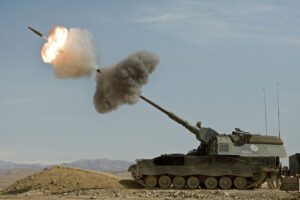
The German company Krauss-Maffei Wegmann offered Ukraine to buy 100 Panzerhaubitze 2000 self-propelled howitzers, the German edition of Welt reports, citing its own sources in the Ukrainian government.
It is noted that the corresponding proposal of the company was redirected by Ukraine to the Federal Ministry of Economics of Germany.
“The cost of 100 howitzers, including training kit and spare parts, is 1.7 billion euros. We are talking about the Panzerhaubitze 2000. As an alternative, KMW also offers howitzers in an unmanned version on the Boxer armored personnel carrier for 1.2 billion euros. No comments from the manufacturer in not received in the near future,” the statement said.
It clarifies that tank-like howitzers are not usually found in the front ranks of an army, but follow, for example, main battle tanks for support from the background at longer ranges.
“For self-defense, a self-propelled howitzer can also attack the target directly, like a main battle tank with a horizontal barrel. After firing off the ammunition, howitzers usually change position so as not to become a target themselves,” the journalists of the publication emphasize.
They note that the Panzerhaubitze 2000 can fire at a distance of more than 30 kilometers. Their delivery to Ukraine, according to Ukrainian government sources with reference to the KMW proposal, will be carried out according to the ring scheme.
“The Bundeswehr will provide Kiev with 100 of its howitzers as soon as possible. The resulting gaps will then be filled by the military industry in the second stage,” the publication specifies.
They add that the first new howitzers can be delivered 30 months after the signing of the contract, that is, not earlier than in the second half of 2024.
“The full delivery will not be completed until 2027. The Ministry of Economy, which, according to the Ukrainian version, received the offer, did not wish to comment on the request and referred to the fundamental confidentiality of individual decisions on arms exports. Any such decision must be approved by the Federal Security Council,” the statement said. journalists.
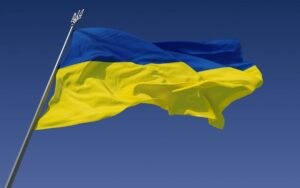
The Cabinet of Ministers has legally confirmed the decision to terminate trade relations with the Russian Federation, Deputy Prime Minister and Minister of Economy of Ukraine Yulia Svyrydenko has said.
“A very important decision was made. This is a legal confirmation of the actual termination of trade relations with the Russian Federation, which happened on February 24,” Svyrydenko said on the national telethon on Saturday evening following the government meeting.
According to her, such a decision would annually block Russia’s foreign exchange earnings by at least $6 billion.
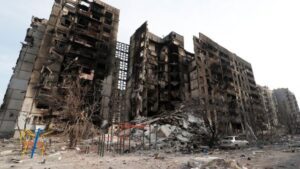
Losses among civilians from February 24, when Russia started the war against Ukraine, until 24:00 on April 8, amounted to 4149 civilians (in the report a day earlier – 3893), including 1766 dead (1626), reports the Office of the UN High Commissioner for Human Rights on Saturday.
The daily summary traditionally states that the increase in indicators in it should not be attributed to the previous report only for cases that occurred on April 8, since during the day OHCHR also verified a number of cases that occurred in previous days, however, the increase in the number of deaths is largest in the entire war.
“OHCHR believes that the actual figures are much higher as information is delayed from some areas of intense fighting and many reports are still awaiting confirmation,” the document says.
According to him, this applies, for example, to Mariupol and Volnovakha (Donetsk region), Izyum (Kharkiv region), Popasnaya (Luhansk region), Borodyanka (Kyiv region), where there are reports of numerous civilian casualties. They are subject to further verification and are not included in the above statistics.
“The majority of civilian deaths or injuries were caused by the use of explosive devices with a wide area of effect, including shelling from heavy artillery and multiple launch rocket systems, as well as rocket and air strikes,” the report says.
According to confirmed UN data, 452 men, 284 women, 43 boys and 27 girls died, while the sex of 69 children and 891 adults has not yet been determined.
Among the 2,383 wounded are 45 girls and 44 boys, as well as 126 children whose gender has not yet been determined.
Compared to the previous day, seven children were killed and 18 more injured, according to the UN.
OHCHR indicates that in Donetsk and Luhansk regions, as of midnight on April 9, there were 560 (432) dead and 944 (842) injured in government-controlled territory, and 70 (67) dead and 269 (263) injured in territory controlled by self-proclaimed “republics”.
In other regions of Ukraine under government control (in Kyiv, as well as in Zhytomyr, Zaporozhye, Kiev, Sumy, Odessa, Mykolaiv, Kharkiv, Kherson, Dnepropetrovsk, Cherkasy and Chernihiv regions), the UN recorded 1136 (1127) dead and 1170 (1162) wounded .
The report also states that, according to the Office of the Prosecutor General of Ukraine, as of 08:00 on April 9, 176 (167) children were killed, 324 (306) were injured.
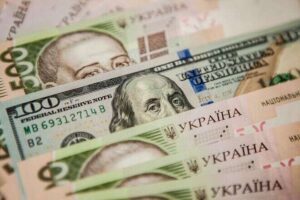
In the week from April 4 to 8, the National Bank of Ukraine again sold more currencies than it bought: dollars – by $ 211 million, euros – by EUR 84.9 million, which, however, is more than two times less than a week earlier, when the “net” sale amounted to $282.1 million and EUR299.8 million.
According to the NBU on its website, this week it bought only $11.5 million and EUR5.5 million, while their sale amounted to $222.5 million and EUR90.3 million.
As reported, in the first week and a half after the war started by Russia on February 24, the “net” purchase of foreign currency by the National Bank amounted to $690.3 million and EUR20 million, since the ban on the purchase of foreign currency had just been introduced, and the list of critical imports had not yet been significantly expanded.
However, in the following weeks, the volume of currency purchases by the central bank began to fall, while the volume of its sale increased. At the same time, last week was the first when the growth trend of “net” sales stopped, and its volumes even slightly decreased compared to the previous week: to the equivalent of $611.9 million from $618.6 million a week earlier, and this week they fell twice at once.
In total, since the beginning of the year, the National Bank has purchased $1 billion 778.8 billion and EUR80.2 million on the market, and sold $4 billion 501.9 million and EUR1 billion 82.7 million, including since the beginning of the war the purchase of foreign currency amounted to $1 billion 121.9 million and EUR80.2 million, and the sale of $1 billion 731.7 million and EUR1 billion 82.7 million.
Ukraine’s international reserves as of April 1, 2022, according to preliminary data, amounted to $28 billion 107.5 million (in equivalent), which is 2% more than at the beginning of March ($27.538 billion).
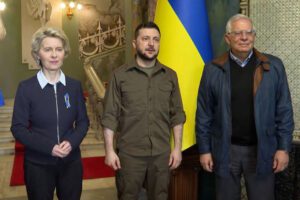
The President of the European Commission, Ursula von der Leyen, handed over to the President of Ukraine Volodymyr Zelensky a questionnaire for joining the EU.
“Here we have intersecting roads, your road to the EU begins, this is already a close path. I will give you this folder, this questionnaire, here are the questions, you need to answer them. These are formal recommendations,” Leyen said at a press conference with President of Ukraine Volodymyr Zelensky in Kyiv on Friday.
Leyen stressed that Ukraine’s place is in the European family.
“We are with you in your dreams of Europe. I want to say very clearly: Ukraine has a place in the European family. We heard this statement from all your people, and we give you a positive answer to your request. This folder contains a very important stage of your arrival to this family. This is the basis for our discussions in the coming weeks,” she said.
In addition, the President of the European Commission stressed that this process will not last for years, as usual, but only weeks.
“Whatever the result, Ukraine has a very big step to recover, because Russia is brazenly destroying the infrastructure of Ukraine, the city of Ukraine. Therefore, we want to work together with you to reform Ukraine, restore Ukraine. This will positively determine Ukraine’s path to the EU “, Leyen also said.
She explained how the process usually takes place. “After a country submits an application, the Council of the EU decides that the Commission should issue its conclusion. Usually, it takes years. In the case of Ukraine, we are talking about weeks. We handed over our questionnaire, it will be filled in negotiations between Ukraine and the EU. This will be a picture of what is happening in the country, whether the country meets the Copenhagen criteria,” she said.
According to Leyen, Ukraine and the EU have agreed and committed that they will work on this important step to get all the answers to these detailed questions.
“It’s not just one question that determines our conclusion, there are a lot of questions that need to be answered. We want to work shoulder to shoulder in order to paint a picture of the country and the path to Europe. After that, the Commission issues its conclusion, which is recommendation to the Council of the EU and after that the Council is already deciding on the next steps,” she said.

The growth of consumer prices in Ukraine in March 2022 accelerated to 4.5% from 1.6% in February, 1.3% in January and 0.6% in December, the State Statistics Service (Gosstat) reported on Friday.
In March last year, inflation was 1.7%, so in annual terms, in March this year, it rose to 13.7% from 10.7% in February and 10% in January, the agency said.
Core inflation also jumped to 3.8% last month from 1% in February and 0.1% in January. Taking into account 1.7% in March 2021 in annual terms, it increased to 10.5% from 8.2% in February and 7.6% in January.
Since the beginning of this year, for its first quarter, inflation was 7.6%, base – 4.9%, said the State Statistics Service.
The National Bank of Ukraine, as its head Kirill Shevchenko said in an interview with Ekonomicheskaya Pravda, estimated inflation in March at 2.1%, in annual terms – 11.1%, and the base – 8.5%, indicating that deviations from the pre-war forecast (respectively 9.2% and 8.2%) – moderate.
According to the State Statistics Service, prices for food and non-alcoholic beverages rose by 6.2% in the consumer market in March. Most of all (by 21.3% and 15.5%) rose in price fruits and vegetables. Prices for rice, cereal products, sugar, lard, sunflower oil, fish and fish products, pasta, butter, milk, cheese and eggs, soft drinks, meat and other products increased by 9.8-3.5%.
Clothes and footwear went up by 13%, incl. clothing – by 13.3%, footwear – by 12.5%.
The increase in prices (tariffs) by 0.5% for housing, water, electricity, gas and other types of fuel was mainly due to an increase in prices for rental housing by 4.0%, maintenance and repair of housing – by 2.2%.
Prices in the healthcare sector rose by 5.6%, primarily due to an increase in the cost of pharmaceutical products by 8.1%.
The 4.2% increase in transport prices was mainly due to a 7.7% increase in fuel and oil prices.
As reported, in 2021, inflation in Ukraine rose to 10% from 5% in 2020 and 4.1% in 2019, the core inflation to 7.9% against 4.5% a year earlier.